Childhood obesity is considered a global epidemic. Increased consumption of fruit and vegetables can decrease health risks associated with obesity. Despite numerous health benefits associated with vegetable consumption, US children fall short of the intake levels recommended by USDA. As the most commonly eaten vegetable in the US, the potato has the potential to address this issue. In this study, we provided roasted colored (red skin-red flesh, yellow skin-yellow flesh and purple skin-purple flesh) potatoes to school children to evaluate acceptance as a vegetable source. In general, the colored potatoes were well accepted by the children surveyed. Nutritional analyses associated with these colored potatoes found that they are rich in total phenolics, antioxidants and vitamin C content. Given the favorable acceptance of colored flesh potatoes, they represent a unique opportunity to increase intake of colorful, health promoting vegetables in children.
Childhood obesity is considered a global health crisis and is associated with adult obesity along with high cholesterol, Type II diabetes, sleep apnea, stroke, hypertension, heart attack and premature death [1]. In the United States, almost one third of youth aged 2 to 19 years of age and two-thirds of adults are either overweight or obese [2]. Suboptimal dietary patterns in the United States are contributing to epidemic levels of obesity and chronic disease. Research suggests that fruit and vegetable consumption is associated with decreased risk for obesity, heart disease, stroke, certain forms of cancer and Type II diabetes [2,3]. Despite the numerous health benefits associated with vegetable consumption, the majority of children and adults in the United States fall short of the intake levels recommended by the United States Department of Agriculture [2,3].
As one of the highest yielding crops per hectare of arable land, the cultivated potato (Solanum tuberosum L.), the third most important food crop next to rice and wheat, has the potential to address this issue (FAOSTAT data). The cultivated potato is most commonly eaten vegetable and is grown in over 150 countries (FAOSTAT data). Potatoes have a high nutritional value: high fiber content, an excellent source of potassium, rich in vitamin C and high in antioxidants [4]. Colored potatoes are considered more nutritious than white potatoes because of their increased phytonutrient content [5].
Phenolic acids, flavonoids, anthocyanins, and carotenoids are the major groups of polyphenolic compounds that constitute the phytochemicals in the colored-flesh potato tubers. Potato tubers with red and purple flesh are known to have high phenolic compound contents [5,6]. Common phenolic acids in potatoes are chlorogenic acid, caffeic acid, cinnamic acid, p-coumaric acid, ferulic acid and sinapic acid. Chlorogenic acid is the predominant phenolic acid in potatoes; it constitutes approximately 80% of the total phenolicacids [5]. In addition to common phenolics, red-and purple-fleshed potato tubers contain large amounts of flavonoids including acylated anthocyanins. Red-fleshed potatoes contain acylated glucosides of pelargonidin; purple potatoes also contain acylated glucosides of malvinidin, petunidin, peonidin and delphinidin [5,6].
Antioxidant activity is the ability of redox molecules in foods and biological systems to scavenge free radicals. The marketing of so-called super foods is commonly based on their antioxidant potential. Dietary polyphenolic compounds provide a significant antioxidant property via synergistic effects of all antioxidants rather than the effects of single compounds. In potatoes, Total Phenolics (TP) and the Total Anthocyanins (TA) contribute to overall antioxidant capacity [5,6]. Although various reports are available on polyphenols and the antioxidant capacities of various potato cultivars, sensory studies related to polyphenols are limited.
Childhood is a critical time for the formation of dietary habits and exposure to healthier food choices. As such, the objective of this study was to determine the acceptability of roasted colored potatoes in school-age children and quantify the health benefits associated with these potatoes, particularly those associated with high antioxidant activity.
Potatoes
Three potato varieties: AmaRosa (red skin-red flesh), Purple Pelisse (purple skin-purple flesh and Yukon Gold (yellow skin-yellow flesh) were used in this study. Fresh potatoes were scrubbed in running water and cut into approximately one-inch cubes with skins left intact. The cut potatoes pieces were then coated with 15ml canola oil, 2.8g salt and 1.5g of garlic powder per pound of potato following the Food Hero Potato Pals recipe (http://foodhero.org/recipes/potato-pals). Food hero recipes adhere to strict criteria for nutrition, appeal, ingredients, and serving size; many Food Hero recipes are credited to meet meal pattern requirements of the National School Lunch Program [7]. The potatoes were placed on sheet pans lined with parchment paper and roasted in a commercial convection oven at 400oF (204oC) for approximately 14 minutes or until the potatoes were completely cooked.
Taste study: During lunch periods in school cafeterias at one elementary school (kindergarten-5th grade) and two middle schools (6th-8th grades) in Hermiston (OR) and Umatilla (OR), students were offered an approximately two tablespoon sample of freshly roasted potatoes. Both the Yukon Gold and Purple Pelisse potatoes were sampled at the two middle schools and the AmaRosa was tried by students at the elementary school. After tasting the potatoes, student acceptance was evaluated using the Food Hero bean count vote system [7]. Three opaque containers, each with a small hole in the lid, were displayed for students (Figure 1). One container was labeled with a smiley face and “Like”, the second featured a neutral face and “Sort of” and the third container depicted a sad face and “Don’t like yet”. Students individually placed a dried lima bean into one of the three containers to indicate how they felt about the potato sample provided to them. Upon conclusion of the lunch, the beans in each container were counted.
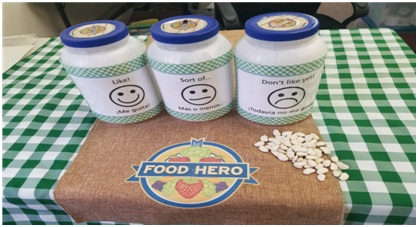 Figure 1:
Figure 1: Picture showing voting bins and beans used in the study.
Antioxidant activities
Extraction of antioxidants: Freshly cut and roasted potato tubers from each taste study were flash frozen in liquid nitrogen and freeze-dried. Phenolics and anthocyanins were extracted from the freeze-dried products of fresh and roasted tubers using aqueous methanol (80%). Total Phenolics (TP) were extracted from tubers of Purple Pelisse, AmaRosa and Yukon Gold using the methods described by [8], following the Folin Ciocalteu method. TP were quantified as µg of gallic acid equivalent per gram of dry weight using a 5-point calibration curve with an R2 value of 0.995. The total monomeric anthocyanins were determined by the pH differential method [9]. Absorbances of methanolic extraction of potatoes were measured at 515 and 700nm for at pH 1.0 and 4.5 solutions. Total anthocyanin content was extracted only from the colored potatoes (Purple Pelisse and AmaRosa) as yellow potato cultivars do not contain any anthocyanins and the anthocyanin content was calculated using the following equation:
Total monomeric anthocyanin, (cyanidin-3-glucoside, mg/L)=(A × MW × DF × 1000)/ε × l where:
A=(A515-A700) pH 1.00-(A515-A700) pH 4.5;
MW(molecular weight)=449.2g/mol for cyanidin-3-glucoside (C3G);
DF=Dilution Factor;
l=Path length in cm,
ε=26,900 molar extinction coefficient in L × mol-1 × cm-1cor C3G and
1000=Factor for conversion gram g to mg.
The total anthocyanins were reported as µg/g dry weight potato tubers.
Extraction and analysis of vitamin C: Vitamin C was extracted using 2.5% metaphosphoric acid containing 1% dithiothreitol and analyzed by the HPLC method using C18 column and photodiode array detector [10]. The eluting solvent was 2.5% metaphosphoric acid with a flow rate of 1.23 mL/min and an absorbance reading at 254 nm.
Antioxidant activity determinations DPPH assay: Antioxidant activities were evaluated with the free radical 2, 2-Diphenyl-1-Picryl-Hydrazyl (DPPH) [6]. Absorbances of DPPH radical were measured at 515nm in the presence and absence of methanolic extract of potatoes. Aliquots were prepared by adding 20µl aliquots of the extract to 20µl of distilled water in a 96-well flat-bottom edmicroplate on ice. Added to this were 200µl of 120mg-l DPPH radical solution (using methanol as a solvent) followed by thorough mixing. Absorbance was measured at 515nm after keeping the plates in the dark for 30min on ice. Each plate included a 20µl of methanol (no extract) control.
Scavenging activities were calculated as:
DPPH radical-scavenging activity (%)=[(Acontrol-Asample/Acontrol)] × 100
Where: A is absorbance at 515 nm.
All experiments were carried out in triplicate and statistical analyses were performed by one-way Analysis of Variance (ANOVA) at a p≤0.05 significance level. The results were expressed as the mean±standard deviation. Significant differences are denoted by different letters, same or shared letters indicate no significant difference.
Acceptance survey
The Food Hero bean count vote system (Figure 1) was employed to study initial acceptance of roasted potatoes colored among the school children. This method has the advantage of speed and less disruption to the lunch time routine, factors that important to school staff in allowing the tasting experiences. Future acceptance studies utilizing a paper survey to collect more information about taste and appearance of the potatoes as well as preferences by age, grade and gender would be useful. The results of the acceptance survey are presented in Table 1. The AmaRosa potatoes (red flesh and red skin) were well accepted by 70% of the children (n=445) indicating that they liked the potatoes and an additional 15% voting that they “sort of” liked them. For the Yukon Gold (yellow flesh and yellow skin), 65% of the students (n=786) indicated that they liked the yellow roasted potatoes with another 25% “sort of” liking them. The percentage of children (n=768) voting that they liked the Purple Pelisse roasted potatoes (purple flesh-purple skin) was lower at 51%, with 32% “sort of” liking this variety. However, it is important to note that potatoes with purple and red flesh are not widely available where this study was completed. Multiple exposures to novel foods often increase acceptability in children [11]. Repeating taste surveys after numerous exposures to these potatoes would yield more information about acceptability to children.
| |
Purple Pelisse |
% |
Yukon Gold |
% |
AmaRosa |
% |
| Like |
390 |
51% |
511 |
65% |
312 |
70% |
| Sort of…. |
246 |
32% |
197 |
25% |
68 |
15% |
| Don’t like yet |
132 |
17% |
78 |
10% |
65 |
15% |
| Total |
768 |
|
786 |
|
445 |
|
Table 1: Acceptance survey results from school children tasting colored roasted potatoes.
Note: Results are from two middle schools and one elementary school in Hermiston (OR) and Umatilla (OR) school districts.
Initial acceptance rates of red, purple and yellow potatoes indicate that colored potatoes may be a means to increase consumption of antioxidant-rich vegetables among children through foods they enjoy eating. Given the large number of children in the US who consume school-prepared meals each day [12], the school setting has the potential to impact nutrient intake and thus, the health of the children. Although purple colored potatoes were less preferred by school children in this study, an increased exposure to these potatoes may likely improve their acceptability, which warrants further research.
Antioxidants and antioxidant activitie: We measured the Total Phenolics (TP) in whole potato tubers and roasted potato pieces using spectrophotometric methods. The TP content in Purple Pelisse, AmaRosa and Yukon Gold are shown in figure 2. Purple Pelisse had the highest levels of TP, followed by AmaRosa and Yukon Gold. These results are consistent with previous studies of potato cultivars with distinguishing flesh and skin colors. These studies showed that red and purple fleshed potato tubers had higher TP than white or yellow ones [6,13]. Unlike many vegetables, potatoes are generally consumed after cooking. Thus, we tested total phenolic content after roasting the samples, and observed a 36.65, 27.68 and 46.44 percent reduction of TP for Purple Pelisse, AmaRosa and Yukon Gold, respectively. It is likely that cooking could affect the content of individual phenolic compounds in potatoes. Similar reductions in TP in potato tubers after processing by different cooking methods have been reported [6]. Whereas some reports indicated the reduction of total phenolic compounds, some studies found increased amounts after cooking. However, the results of greater amounts of phenolic compounds are mostly due to the higher extractability of phenolic compounds from the cellular matrix of cooked potatoes [14].
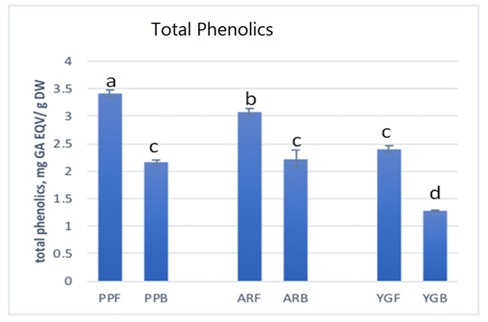 Figure 2:
Figure 2: Total phenolics associated with colored potatoes.
Note: (PPF-Uncooked Purple Pelisse, PPB-roasted Purple Pelisse; ARF-Uncooked AmaRosa, ARB-roasted AmaRosa; YGF-Uncooked Yukon Gold, YGB-roasted Yukon Gold). Data are mean of three replicates and error bars represent standard deviations. Significant differences are denoted by different letters, same or shared letters indicate no significant difference.
The total anthocyanin content of Purple Pelisse and AmaRosa are shown in figure 3. Purple Pelisse had higher levels of anthocyanin than the red-fleshed potato tuber AmaRosa. A number of reports available on the anthocyanin content of colored flesh potato tubers indicated up to 40.0mg per 100g Fresh Potato Weight (FW) [5,6]. The major anthocyanins in potatoes are pelargonidin, cyanidin, delphinidin, peonidin, petunidin and malvinidin [15]. Comparative studies on the anthocyanin and its potential antioxidant properties demonstrated that purple-fleshed potato tubers have an anthocyanin content comparable to that of pomegranates and blueberries [8,16]. Baking or roasting resulted in degradation of anthocyanin in the potatoes. Purple Pelisse lost 33.79% and AmaRosa lost 16.42% as a result of baking. Thus, AmaRosa retained higher levels of anthocyanins compared to its raw state than did Purple Pelisse. Contradictory reports were obtained from various studies of changes to anthocyanin content after cooking. While some of the reports indicated higher levels of anthocyanins in cooked potatoes than in raw ones [17], other studies reported significant reductions [6,18]. It was interesting to note that Purple Pelisse and AmaRosa had a considerable amount of total anthocyanins, even after cooking (Figure 3).
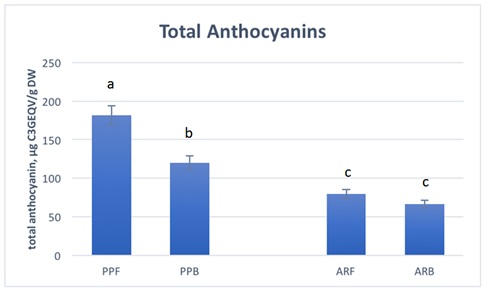 Figure 3:
Figure 3: Total anthocyanin content measured from colored flesh potatoes.
Note: (PPF-Uncooked Purple Pelisse, PPB-roasted Purple Pelisse; ARF-Uncooked AmaRosa, ARB-roasted AmaRosa). Data are mean of three replicates and error bars represent standard deviations. Significant differences are denoted by different letters, same or shared letters indicate no significant difference.
Vitamin C is necessary for normal connective tissue structure and function, contributes to cell protection from free radical damage and improves iron absorption by the human body. The National Institute of Health recommends 90-120mg of vitamin C consumption per day for healthy adults. The vitamin C content varies widely among potato varieties and depends on pre-harvest and post-harvest conditions. In addition, vitamin C concentrations in potatoes vary as a function of the production region [19]. Total vitamin C content (ascorbic acid and dehydroascorbic acid) in Purple Pelisse, AmaRosa, and Yukon Gold are shown in the figure 4. Yukon Gold has highest vitamin C content followed by AmaRosa and Purple Pellise with the values 72.03, 67.59, and 61.70mg/100g dry weight (DW) respectively. Loss of vitamin C from the cooking process is on the order of 48.84, 57.78 and 47.44 percent reduction for Yukon Gold, AmaRosa and Purple Pelisse with AmaRosa losing more than half of its vitamin C content by roasting (4). Vitamin C losses observed in this study were similar to those reported in previous studies [6,19].
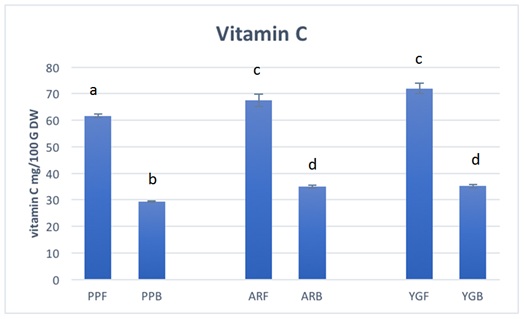 Figure 4:
Figure 4: Total vitamin C content of colored flesh potatoes.
Note: (PPF-Uncooked Purple Pelisse, PPB- roasted Purple Pelisse; ARF-Uncooked AmaRosa, ARB- roasted AmaRosa; YGF-Uncooked Yukon Gold, YGB-roasted Yukon Gold). Data are mean of three replicates and error bars represent standard deviations. Significant differences are denoted by different letters, same or shared letters indicate no significant difference.
Antioxidant activity DPPH radical-scavenging activity: DPPH (1,1-Diphenyl-2-picrylhydrazyl) is a stable free radical that accepts an electron or hydrogen, with a corresponding change from a violet color to pale yellow in solution, and has been ubiquitously used to test the free radical-scavenging ability of various samples. The reduction capability of the DPPH radical was determined by a decrease in absorbance at 515 nm induced by antioxidants. Extracts of Purple Pellise and AmaRosa showed upto 89% radical scavenging activity and while Yukon Gold showed about 27%. Total phenolics and total anthocyanin are closely associated and positively correlated with antioxidant activities. Most of the studies suggested that rather than a single antioxidant compound, it is a synergestic affect of multiple antioxidants that contributes to the scavenging activities of radicals [20]. Figure 5 shows the DPPH-scavenging activity of the methanolic extracts of Purple Pelisse, AmaRosa, and YukonGold. Among these three potato varieties, Purple Pelisse and AmaRosa had very strong DPPH reduction activity compared to Yukon Gold. Further, the methanol extract of roasted potato tubers showed the same range of radical scavenging activity as raw potatoes, although cooking reduced the levels of phenolics and anthocyanins (Figures 2 & 3). Yang et al. [21], found that the average antioxidant activity of a fresh sample increased after cooking by various methods, with the largest increase found in the microwave treatment. Similarly, Burgos et al. [22], reported that antioxidant activity increased by 10.67% after boiling purple-fleshed potatoes. Blessington et al. [14], reported 42.72 and 68.18 percent increase in antioxidant activity after cooking by baking and microwaving methods, respectively. They suggested that increase in the antioxidant activity may be associated with the increase of extractability of the antioxidant compound from the food matrix due to the structural changes to starch during the cooking processes. The high antioxidant activity of AmaRosa and Purple Pelisse, even after cooking, further supports the health benefits of colored potato tubers.
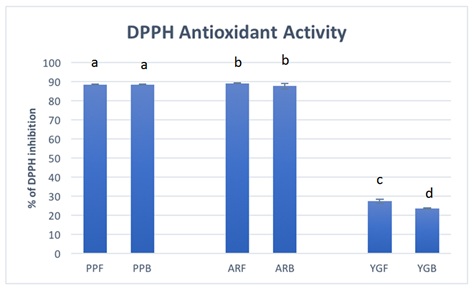 Figure 5:
Figure 5: DPPH antioxidant activity measured from colored potatoes.
Note: (PPF-Uncooked Purple Pelisse, PPB-roasted Purple Pelisse; ARF-Uncooked AmaRosa, ARB-roasted AmaRosa; YGF-Uncooked Yukon Gold, YGB-roasted Yukon Gold). Data are mean of three replicates and error bars represent standard deviations. Significant differences are denoted by different letters, same or shared letters indicate no significant difference.
The Scientific Report of the 2015 Dietary Guidelines Advisory Committee asserts fruit and vegetable intake as the only dietary characteristic consistently associated with positive health outcomes in all conclusion statements of the studies reviewed. Thus, ensuring adequate fruit and vegetable intake by children is critical. Colored-flesh potatoes represent a unique opportunity to increase intake of health-promoting vegetables in children, particularly when prepared so as to minimize added fats and sodium. White potatoes are the most commonly consumed vegetable in the United States [2,3]; colored-flesh potatoes are likely to be well accepted by children for the characteristics they share with white potatoes, while offering higher levels of health beneficial phytochemical and antioxidants. Results of this study bolster evidence for the health-benefitting antioxidant properties of colored-flesh potatoes. This is important given that the potato is often not counted as a vegetable in published studies related to health [2]. School cafeterias feed millions of children each day, directly impacting their diets. Our study concludes that there is a high level of acceptance of colored-flesh potatoes among school-aged children. Providing these antioxidant-rich vegetables as a component of school lunches could contribute to establishment of healthful dietary intake patterns.
We thank Alissa Daltoso, Betsy Heath, Keenan Beil, Moises Aguilar, Rikkilynn Larsen, Ryan Graebner and Tianxio Li for their help with the taste study. This study is supported by funds from Oregon Potato Commission and Colorado State Potato Commission. Oregon SNAP-Ed funding supported the cafeteria tastings, but no SNAP-Ed funds were used for publication costs.
VS, AT and SJ conceived the study. AT, VS and LT performed the taste study. DK and SJ performed nutritional analysis. VS provided all the potatoes used in the study. All the authors wrote and critically reviewed and approved the manuscript.
The authors declare no conflict of interest. The research protocol followed funder guidelines, but the funding sponsors were not involved in the collection, analyses, or interpretation of data, in the writing of the manuscript, and in the decision to publish the results.

 Figure 1: Picture showing voting bins and beans used in the study.
Figure 1: Picture showing voting bins and beans used in the study. Figure 2: Total phenolics associated with colored potatoes.
Figure 2: Total phenolics associated with colored potatoes. Figure 3: Total anthocyanin content measured from colored flesh potatoes.
Figure 3: Total anthocyanin content measured from colored flesh potatoes. Figure 4: Total vitamin C content of colored flesh potatoes.
Figure 4: Total vitamin C content of colored flesh potatoes. Figure 5: DPPH antioxidant activity measured from colored potatoes.
Figure 5: DPPH antioxidant activity measured from colored potatoes.
